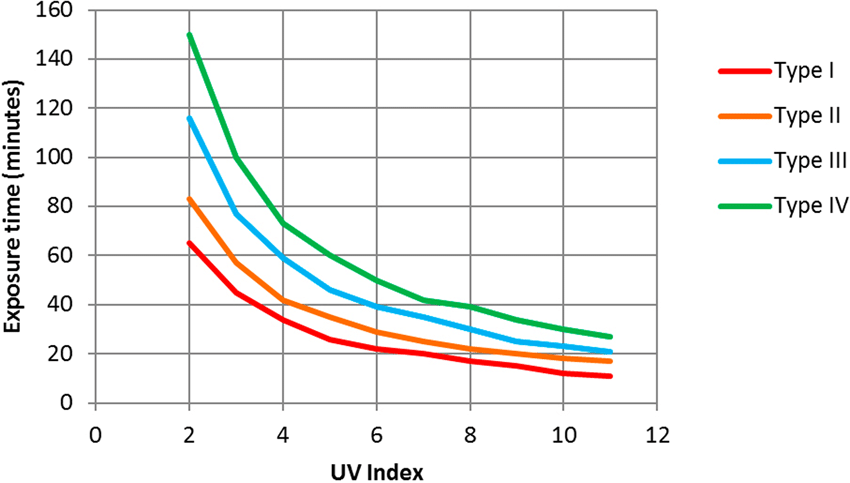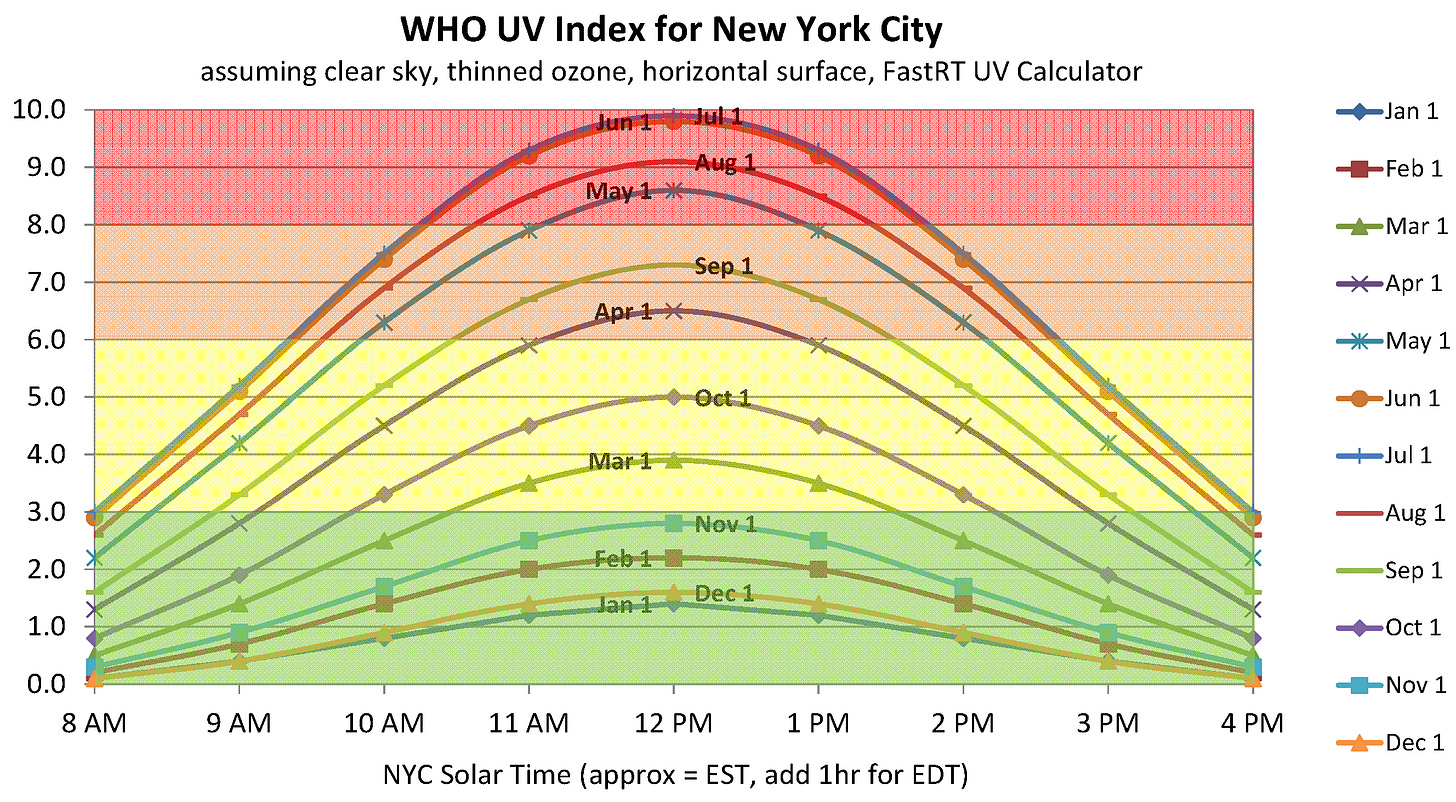Can I go out without sunscreen?
UV Index, Sun Elevation and the protecting Effect of the Atmosphere
Although the sun’s high energy radiation, UV light, is never completely blocked by the atmosphere, the dose rate is reduced to a safe level whenever the sun is below 20° of elevation, which is roughly 2 hours before sunset.
If you don’t care much about the science, there’s not much more to see here.
Perhaps you want to have a look at the graphs?
Or maybe you are about how I came to these conclusions.
Let’s work out some basics!
Sunburn usually occurs when the entire UV dose by your skin exceeds a threshold.
For fairly light-skinned (type II) people like myself, that dose threshold lies at around 2–3 UVI*hours, corresponding to 20 or so minutes during full summer daylight (UVI 7).
We see this patter in the hyperbolic relationship between UV Index and exposure time to burn. As you might intuitively expect, at half the intensity it takes twice as long to burn and vice versa.
Okay, so how do we know the current dose rate or UVI so we can figure out how long we can be outside before burning ?
Well, it would be awfully convenient if weather apps just gave hourly UV index forecasts; sadly, that’s not the norm, as they usually only provide daily maximums rather than hourly estimates.
Still, after a bit of digging I found a UVI calculator that took in into account several parameters like the strength of the ozone layer, cloud cover, latitude, season and time.
When I had entered a bunch of (mostly worst case) values corresponding to a clear summer day at 50° latitude, I was armed with a full set of UVI–sun elevation pairs.
To my surprise, the relationship is not linear when the sun is close to the ground but rather quadratic—at very low angles, nearly all UV light has been either absorbed or scattered back out into space, with the little light that has made it through the atmosphere diffusely coming from all angles.
I spent quite a bit of time entering the calculated values and attempting to reverse engineer a simple fit-function to the data, but I’ll spare you the details.
The picture is from the Wikipedia article for UVI and visualizes Data from “FastRV UV Calculator”
We see the huge seasonal differences in UV Index here. During winter, even clear sky thinned ozone conditions at noon don’t push the UVI beyond 3, where it’s generally advised to apply sunscreen. Unless you go skiing in the mountains, where snowcover reflecting light back from the ground and decreased atmospheric attenuation leave enough UV punching through to be a problem, you don’t really have to worry.
Yet even these tiny dose rates can become an issue, assuming you’re exposed for long enough—when working 8 hours outside, don’t take any chances, even in winter!
Quantitatively, a sun elevation of 10° above the horizon results in a measly UVI of 0.2, barely a rounding error! Moreover, even at 20° you are expecting less than 1 UVI.
Considering these values, I’d be much more concerned about generating sufficient vitamin D, also a product of UV light, than potential skin cancer risks.
Now, there are some overzealous dermatologists who apply sunscreen every day without fail, choosing to supplement vitamin D year round instead.
I can’t really fault their logic. After all—if cigarettes and alcohol are damaging from the first draw and drop respectively, why should UV light be any different?
Plus, vitamin D supplements are cheap.
Provided that using sunscreen daily was convenient and had no adverse effects, I would gladly follow their suggestion, but since I was a little kid I couldn’t stand it’s sticky greasy feeling on my skin.
Because it can’t just wash off when swimming at the beach, you’ll also have some trouble removing it under the shower.
Lastly, there are some legitimate concerns over some of the dozens of substances that could be included in your sunscreen. Can they get absorbed into your skin, are they hormonally active or potentially even toxic ?
Hell, there are entire conspiracy theories regarding sunscreen!
(Please don’t fall down that rabbit hole. I think it’s safe to say that sunburn is strictly worse than the potential risks of sunscreen)
In conclusion, we now have scientific backing for many things you may have already intuitively known. We learned that at low sun angles, whether during winter noon or summer evenings, we have only a tiny fraction of the UV radiation of the overhead sun, like during the middle of a summer day.
I also learned that the UV Index of space is about 500, wrote a desmos equation/plot that shows the sun’s path, realized that most UV is scattered before it reaches you and that if you and that writing still doesn’t come super easy to me.
I’ll keep on working on it and hopefully, as time goes on it’ll become more natural and effortless.
Till then, good day, fellow wanderer!






